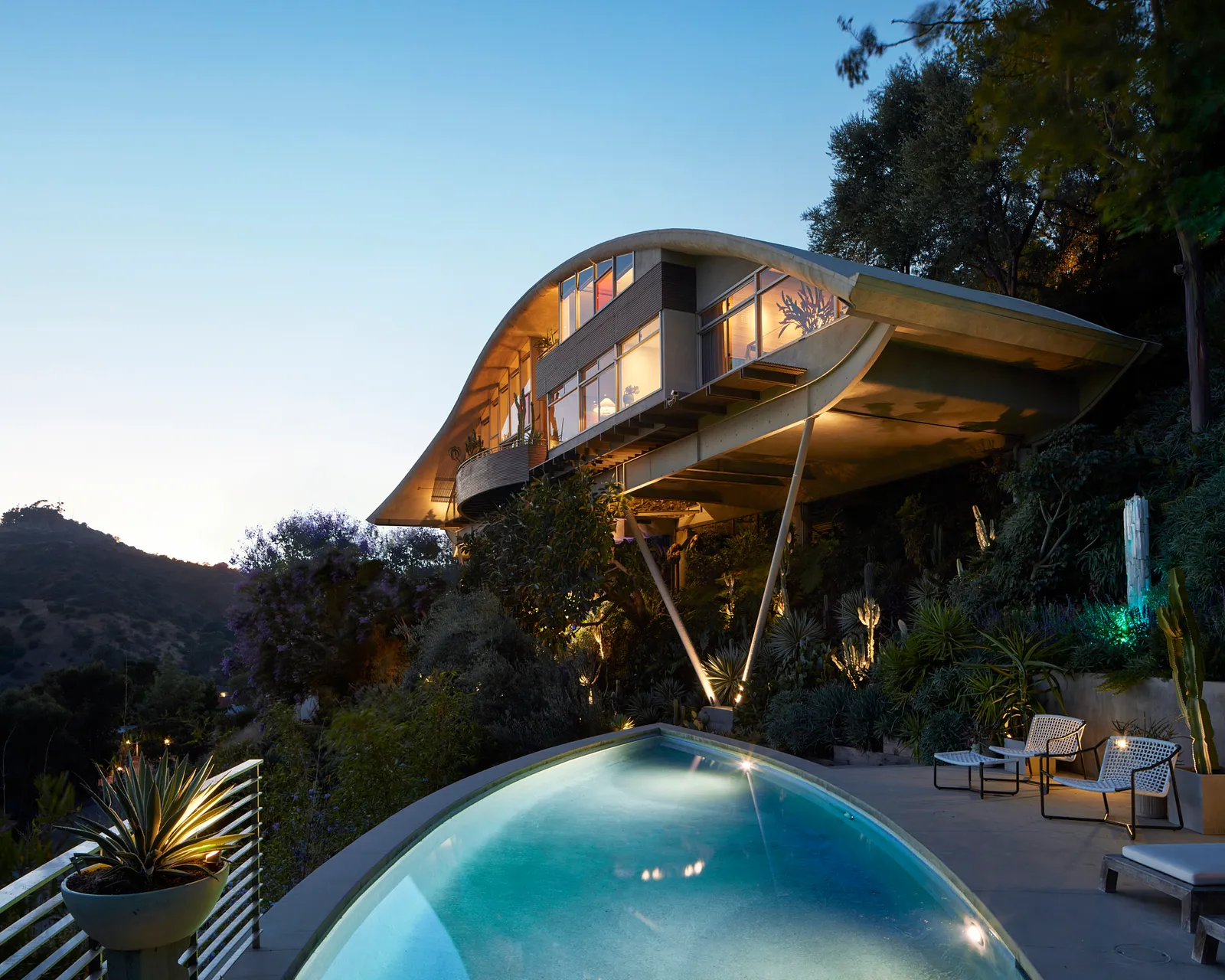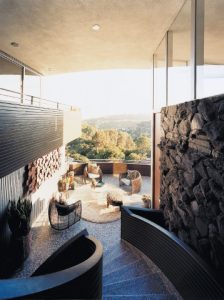
For Sale: The Garcia House – 7436 Mullholland Drive, Los Angeles
Located near the top of coveted Mulholland Drive in the Hollywood Hills, is perched Architect John Edward Lautner’s 1962 Garcia House. Lautner was renowned as an architectural pioneer, known for his ability to design unique residences for properties with impossible terrains as well evidenced by his unique design for the residence of client Russell Garcia, a Hollywood composer and arranger.
To be honest, when I initially came across the listing on this one, my first reaction was not a positive one – I saw the Quonset Hut style of the home as kind of institutional and somewhat gaudy, but the more I study the photos of the home, the rooms the finishes, the flow … the more I begin to appreciate the absolute brilliance of the architect. I mean, the site is nearly vertical and most architects (and clients for that matter) would have taken a quick pass on the project. But … he and Garcia were captivated by the view and successfully tackled the engineering required to create this iconic masterpiece.
Lautner (16 July 1911 – 24 October 1994), was an acclaimed American architect, who studied under Frank Lloyd Wright – how’s that for pedigree? The rainbow shaped residence is suspended 60 feet above Mulholland Drive on steel caissons and faced with a wall of windows 30 feet in height, which frames unobstructed views of the canyon below. If you think about it, it’s a very daring design for an area famous for mud slides and seismic activity – yet the home remains on its delicate perch some 6 decades (and who knows how many earthquakes) later, just as stable as the day Russell Garcia first crossed its threshold.
The 2,596-square-foot home features three beds, three and half bathrooms, terrazzo flooring, a lava rock entryway, and a pool, which was added in 2008.
 The layout of the 2,600 square foot home is strategically designed as two distinct pavilions separated by an open-air courtyard and cascading staircase, all connected by the distinctive parabolic roof. One side of the home contains three bedrooms and office space, with the other side housing the public living and entertaining areas which include a deliciously retro, sunken living room. Supporting the family and guests are three and a half bathrooms. One of the hallmarks of Lautner designed homes is the seamless flow of the exterior spaces which blend naturally with the interiors through large expanses of glass and the use of natural terrazzo flooring, a lava rock entryway and warm wood. Steps descend from the house, through the lushly landscaped .22-acre lot (reimagined by landscape architect John Sharp), to the uniquely almond shaped pool, added in 2008 which completed Lautner’s original design.
The layout of the 2,600 square foot home is strategically designed as two distinct pavilions separated by an open-air courtyard and cascading staircase, all connected by the distinctive parabolic roof. One side of the home contains three bedrooms and office space, with the other side housing the public living and entertaining areas which include a deliciously retro, sunken living room. Supporting the family and guests are three and a half bathrooms. One of the hallmarks of Lautner designed homes is the seamless flow of the exterior spaces which blend naturally with the interiors through large expanses of glass and the use of natural terrazzo flooring, a lava rock entryway and warm wood. Steps descend from the house, through the lushly landscaped .22-acre lot (reimagined by landscape architect John Sharp), to the uniquely almond shaped pool, added in 2008 which completed Lautner’s original design.
In 2002, the home was purchased by an entertainment business manager, John McIlwee and his partner, Bill Damaschke, president of Animation and Family Entertainment for Skydance Media, for $1.3 million. In 2012, the pair embarked on a year-long, $1 million restoration and renovation of the residence led by architect Leo Marmol of Marmol Radziner, the firm who also restored Richard Neutra’s famous Mid Century Modern Kaufmann Desert House in Palm Springs.
In November of 2022 after two decades in the home, McIlwee and Damaschke decided it was time for a change and placed the modernist masterpiece on the market for a cool $16 million.
According to the listing agents site the Garcia House has now been sold. The listing here includes a gallery of additional pictures showing how spectacular this house is. After reviewing these photos, you can imagine how ashamed I now am for my initial Quonset Hut reference – sorry Mr. Lautner.
Side Note: In the movie Lethal Weapon 2 (1989), the Garcia House was utilized as the home of villain Arjen Rudd, Minister of Diplomatic Affairs for the South African Consulate. It was this house where vigilante police officer Martin Riggs (Mel Gibson) uses cables attached to the bumper of his pickup truck tied to the home’s supporting stilts to send it crashing into the ravine below. To complete this scene, a replica of the house was built on the studio back lot at a cost of over $500,000. Due to the cost and the nature of the shot, the producer had only one chance to capture the destruction of the home on film.
Click here to see additional photos of the Garcia House.